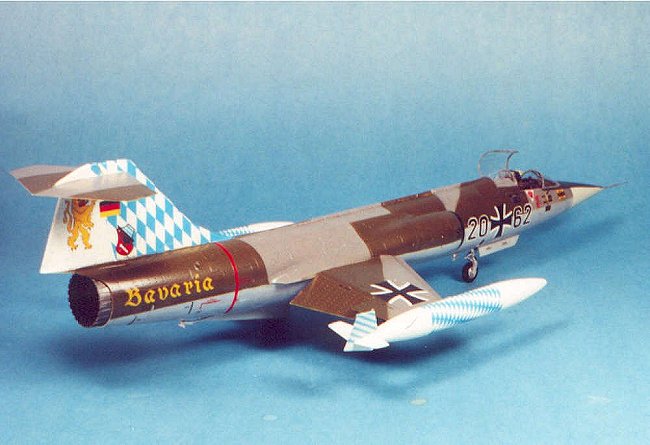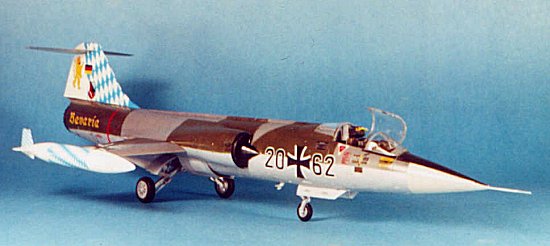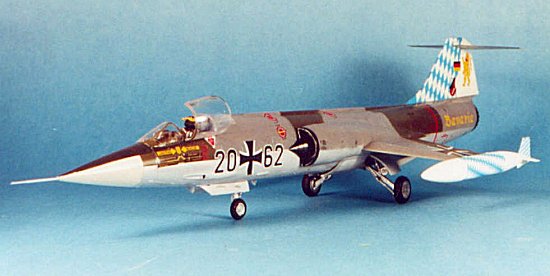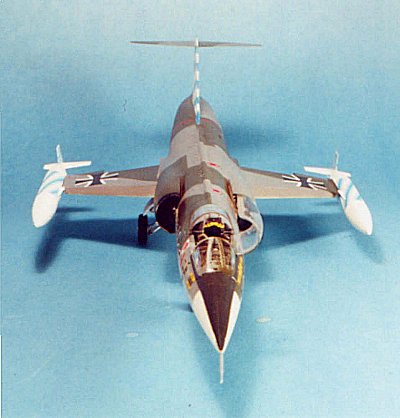
Hasegawa 1/48 F-104G Starfighter
|
KIT # |
7220 |
|
PRICE: |
$29.95 |
|
DECALS: |
See Review |
|
REVIEW: |
|
|
NOTES: |

|
HISTORY |
Far more interesting than the operational history of the F-104G is the tale of how it came to be; this is the kind of "business tale" that would be even better than "Barbarians at the Gate." Fortunately, I have read aviation historian Bill Gunston's excellent telling of this tale in the Starfighter chapter of his superb "Early Supersonic Fighters of the West," and am friends and neighbors with several retired Lockheed employees who were there at the birth of the only international fighter project to be developed around an airplane that was an operational failure, having been rejected by its home country's air force.
In 1952, after talking to US fighter pilots in Korea, Kelly Johnson came back to Burbank firmly committed to developing a lightweight fighter that would fly faster and higher than any other fighter in the world. Unfortunately, the entire history of air combat since the Korean War has been in the opposite direction, with almost all air combat since 1953 happening below 20,000 feet and at subsonic speed. The airplane Johnson designed, the Lockheed F-104 Starfighter, is still one of the most dramatic airplanes ever to see the light of day; 46 years after its first flight, it still looks like it's going a million miles an hour, sitting on the tarmac.
By 1958, Lockheed was well aware that the Air Force did not like the air superiority F-104A, or the tactical nuclear fighter bomber, the F-104C. Rather than the thousands of Starfighters the company had originally foreseen at its first flight in 1954, the airplane was scheduled to go out of production with no new orders with airplane number 292. In that year, however, the new German Luftwaffe began looking for a state-of-the-art airplane to use for tactical nuclear delivery in Europe, a replacement for the service's Republic F-84F fighter-bombers. It was apparent that several other NATO members that also operated the F-84F might also follow the Luftwaffe's lead in choosing a replacement. By December, 1958, there was a hotel in Bonn called "the Lockheedshof", and Federal Defense Minister Franz Josef Strauss had complained that he couldn't open a drawer in his desk without a Lockheed representative falling out of it.
 The Lockheed sales
brochure for the "super Starfighter" read: "In 1956, Lockheed
foresaw that Free World allies, vulnerable to attack by conventional weapons,
had vital need for the high-performing F-104 as a multi-mission fighter."
There were other contenders: an advanced version of the English Electric
"Lightning;" the radical Saunders-Roe S.R. 177; the Grumman G.98
"Super Tiger" which stood out as an oddity among the competitors for
the fact it actually existed; a variant of the SAAB Draken; and what would
become the Mirage III from France. While the British seemed to actively sabotage
their own competitors and the French seemed unhappy that their leading contender
was the product of a privately-owned company, and Grumman seemed to be their own
worst enemy, Lockheed flooded Germany with people who could talk to politicians,
industrialists eager to bring their aerospace industry back to world standards,
and pilots eager to once again be flying "the world's best fighter."
In February 1959, the German government announced that "after evaluating
nearly two dozen of the world's top fighter aircraft," it had chosen the
"Super Starfighter" (which Lockheed had named the F-104G,
"G" standing in this case for "Germany").
The Lockheed sales
brochure for the "super Starfighter" read: "In 1956, Lockheed
foresaw that Free World allies, vulnerable to attack by conventional weapons,
had vital need for the high-performing F-104 as a multi-mission fighter."
There were other contenders: an advanced version of the English Electric
"Lightning;" the radical Saunders-Roe S.R. 177; the Grumman G.98
"Super Tiger" which stood out as an oddity among the competitors for
the fact it actually existed; a variant of the SAAB Draken; and what would
become the Mirage III from France. While the British seemed to actively sabotage
their own competitors and the French seemed unhappy that their leading contender
was the product of a privately-owned company, and Grumman seemed to be their own
worst enemy, Lockheed flooded Germany with people who could talk to politicians,
industrialists eager to bring their aerospace industry back to world standards,
and pilots eager to once again be flying "the world's best fighter."
In February 1959, the German government announced that "after evaluating
nearly two dozen of the world's top fighter aircraft," it had chosen the
"Super Starfighter" (which Lockheed had named the F-104G,
"G" standing in this case for "Germany").
Only one voice in Germany was raised against this decision: Erich Hartmann, the Luftwaffe's top ace of the Second World War, said after flying the F-104 that it was too unforgiving for young German fighter pilots, and that the Luftwaffe should consider an interim type such as the F-100 before bringing such an advanced aircraft into the inventory. His dissent - in the face of support for the airplane from fellow aces now high in the new Luftwaffe command like Johannes Steinhoff, Gunther Rall, and Walter Krupinski - eventually cost him his career. In light of the subsequent operational history of the F-104G in the Luftwaffe, Hartmann was right.
By 1961, Germany, Canada, the Netherlands, Belgium, Italy and Japan had come aboard the "Super Starfighter" program as partners in its construction. The airplane would also serve with the air forces of Norway, Denmark, Greece, Turkey and Taiwan.
 The prescience of
Hartmann's dissent can be seen in the fact that over the time of the
Starfighter's service in these air forces, each one averaged 30-35% losses by
accidents of their total fleet (though the Norwegians lost exactly two of
theirs, and to accidents having nothing to do with the airplane itself), the
highest accident rate of any operational combat aircraft in the West since the
Second World War. The losses in aircraft and pilots in West Germany became a
national scandal in the 1970s; in the Luftwaffe, there was a joke that an
optimist was "a Starfighter pilot who gave up smoking because he was afraid
of dying of lung cancer." As the late Tony Levier once said to me,
"The Starfighter was an airplane that never forgave the slightest mistake,
ever." As Bill Gunston put it: "an experienced pilot would love the
104G and be unlikely to run into trouble, whereas the young Germans who made up
the bulk of the Luftwaffe and Kriegsmarine Starfighter squadrons were far from
experienced." Better training at Luke AFB in the 1970s and a general
shaking-out of bugs led to a reduction in the accident rate in the later 1970s
and 1980s, but the Starfighter was definitely the most difficult of post-war
jets to operate.
The prescience of
Hartmann's dissent can be seen in the fact that over the time of the
Starfighter's service in these air forces, each one averaged 30-35% losses by
accidents of their total fleet (though the Norwegians lost exactly two of
theirs, and to accidents having nothing to do with the airplane itself), the
highest accident rate of any operational combat aircraft in the West since the
Second World War. The losses in aircraft and pilots in West Germany became a
national scandal in the 1970s; in the Luftwaffe, there was a joke that an
optimist was "a Starfighter pilot who gave up smoking because he was afraid
of dying of lung cancer." As the late Tony Levier once said to me,
"The Starfighter was an airplane that never forgave the slightest mistake,
ever." As Bill Gunston put it: "an experienced pilot would love the
104G and be unlikely to run into trouble, whereas the young Germans who made up
the bulk of the Luftwaffe and Kriegsmarine Starfighter squadrons were far from
experienced." Better training at Luke AFB in the 1970s and a general
shaking-out of bugs led to a reduction in the accident rate in the later 1970s
and 1980s, but the Starfighter was definitely the most difficult of post-war
jets to operate.
|
THE KIT |
The F-104G is the third of Hasegawa's new Starfighter kits, after the F-104C and F-104J. Its primary difference from the previous kits is a change in the afterburner exhaust, and the addition of bulged main gear doors, to cover the larger wheels used by the F-104G due to its higher weight compared with the other two versions. It also includes the Martin-Baker GQ-7 seat that replaced the Lockheed C-2 seat in the F-104G. The decal sheet includes aircraft of the German, Italian and Dutch air forces, with the German airplane being in a commemorative for JBG-32 in 1983.
|
CONSTRUCTION |
As reported in the review of the F-104C, the kit is very well-engineered, and goes together with little difficulty. The same is true with the F-104G, which I had assembled within an afternoon of uninterrupted modeling.
|
PAINT & DECALS |
 Painting:
Painting:
I painted the underside as "silver-grey," using a mixture of Tamiya Aluminum with Tamiya Flat White. Before doing this, I had painted and masked the radar nose with Gunze-Sanyo H-338 Light Grey, then painted the anti-glare area with Tamiya XF-26 Deep Green. The upper surface camouflage was done with Tamiya XF-54 Dark Sea Grey and Gunze-Sanyo H-330 Dark Green (BSC381C/641). The model was given a coat of Future and was ready for decals.
Decals:
I used the kit decals to do a commemorative airplane of JBG32 at Memmingen in 1983. They went down under a light coat of Micro-Sol with no trouble.
Weathering:
The color photo of this airplane in Wings of Fame No. 3 shows a very clean airframe with no weathering. I only shot a second coat of Future mixed with a bit of my "Flat Future" mix to bring down the gloss to make it more realistic.
|
CONCLUSIONS |
The F-104 is still the most dramatic-looking fighter ever made - it looks like it's going a million miles an hour just sitting there. I can't think of a scheme the airplane's been painted in that makes it look bad, but almost any commemorative scheme makes it look better. There are several aftermarket sheets currently available for the F-104G in commemorative schemes, and I know of at least one more on the way this next year. I can definitely see myself doing more than one of these with a wilder German or Italian commemorative scheme (in my opinion the Italian schemes are the best). Hasegawa has definitely produced the best F-104 kit ever; I can't wait for the two seater and the F-104S. The kit is extremely well-engineered and even a newcomer can look good with this model, simply following the kit instructions.
Thanks to Marco Polo Imports for the review copy.
If you would like your product reviewed fairly and fairly quickly, please contact the editor or see other details in the Note to Contributors.